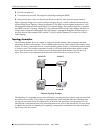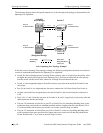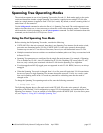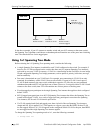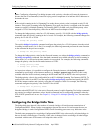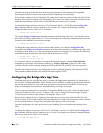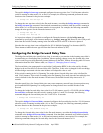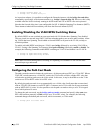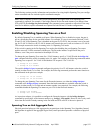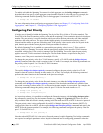
Configuring Spanning Tree Parameters Configuring Spanning Tree Bridge Parameters
OmniSwitch 6600 Family Network Configuration Guide April 2006 page 5-15
Note. Configuring a Spanning Tree bridge instance with a priority value that will cause the instance to
become the root is recommended, instead of relying on the comparison of switch base MAC addresses to
determine the root.
If the switch is running in the 1x1 Spanning Tree mode, then a priority value is assigned to each VLAN
instance. If the switch is running in the flat Spanning Tree mode, the priority is assigned to the flat mode
instance or an 802.1s Multiple Spanning Tree Instance (MSTI). In both cases, the default priority value
assigned is 32768. Note that priority values for an MSTI must be multiples of 4096.
To change the bridge priority value for a VLAN instance, specify a VLAN ID with the bridge priority
command when the switch is running in the 1x1 mode. For example, the following command changes the
priority for VLAN 455 to 25590:
-> bridge 455 priority 25590
The explicit bridge 1x1 priority command configures the priority for a VLAN instance when the switch
is running in either mode (1x1 or flat). For example, the following command performs the same function
as the command in the previous example:
-> bridge 1x1 455 priority 25590
To change the bridge priority value for the flat mode instance, use either the bridge priority command or
the bridge cist priority command. Note that both commands are available when the switch is running in
either mode (1x1 or flat) and an instance number is not required. For example, the following commands
change the priority value for the flat mode instance to 12288:
-> bridge priority 12288
-> bridge cist priority 12288
As in previous releases, it is possible to configure the flat mode instance with the bridge protocol
command by specifying 1 as the instance number (e.g., bridge 1 protocol rstp). However, this is only
available when the switch is already running in the flat mode and STP or RSTP is the active protocol.
The bridge priority value is also configurable for an 802.1s Multiple Spanning Tree Instance (MSTI). To
configure this value for an MSTI, use the explicit bridge msti priority command and specify the MSTI
ID for the instance number and a priority value that is a multiple of 4096. For example, the following
command configures the priority value for MSTI 10 to 61440:
-> bridge msti 10 priority 61440
Note that when MSTP (802.1s) is the active flat mode protocol, explicit Spanning Tree bridge commands
are required to configure parameter values. Implicit commands are for configuring parameters when the
STP or RSTP protocols are in use. See Chapter 6, “Using 802.1s Multiple Spanning Tree,”for more infor-
mation.
Configuring the Bridge Hello Time
The bridge hello time interval is the number of seconds a bridge will wait between transmissions of
Configuration BPDU. When a bridge is attempting to become the root or if it has become the root or a
designated bridge, it sends Configuration BPDU out all forwarding ports once every hello time value.
The hello time propagated in a root bridge Configuration BPDU is the value used by all other bridges in
the tree for their own hello time. Therefore, if this value is changed for the root bridge, all other bridges
associated with the same STP instance will adopt this value as well.



